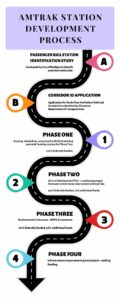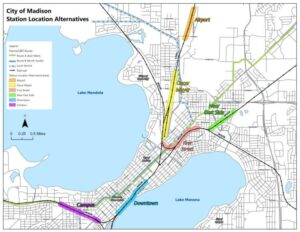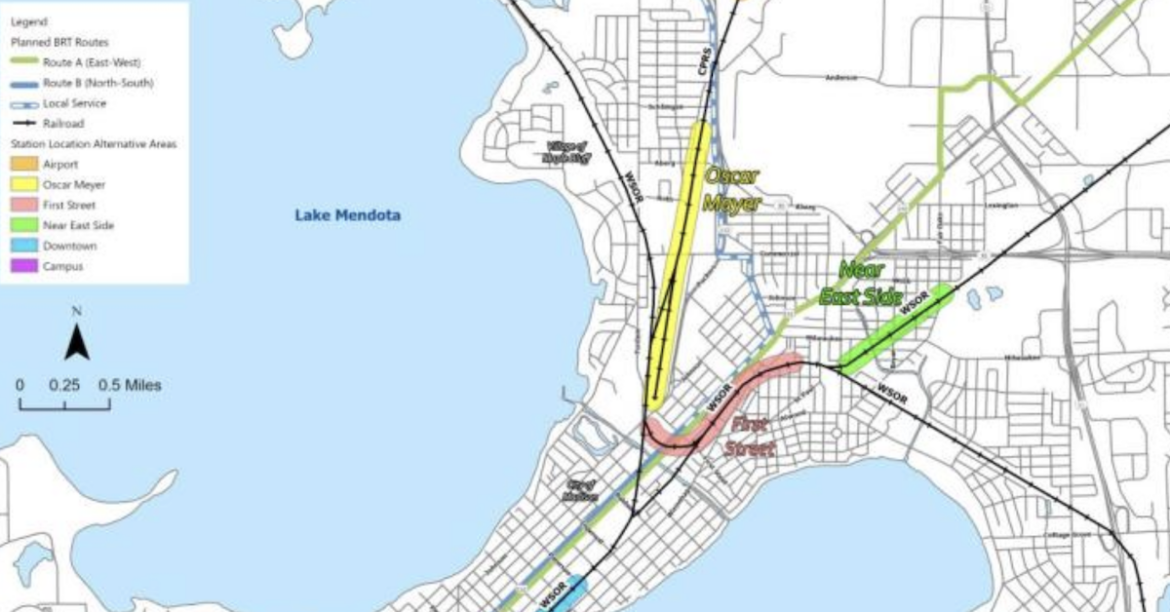When Madison resident Sabah Khan went home to the Twin Cities for Thanksgiving, she boarded one of three buses leaving for the same destination, all at the same time. Clearly, demand was high.
“I’ve wanted a train to connect Chicago, Milwaukee, Madison and Minneapolis for so long,” said Khan, 25. “These are major destinations in our corner of the Midwest and would be so widely used. I can imagine all of the people riding those buses would’ve easily enjoyed taking a train there, too.”
For decades, Madison residents wishing to travel via Amtrak had to make their way to the stations in Chicago, Milwaukee or Columbus first. But a new attempt to establish Madison’s own station has been picking up steam.
In 2021, Amtrak proposed expanding its Hiawatha rail line between Milwaukee and Chicago to include Madison and eventually add connections to Minneapolis and St. Paul as part of a 15-year plan, an idea also supported by the U.S. Department of Transportation.
Now, the city’s capital budget has allocated funds for the project and research to identify a potential station location is underway. The future of the project hinged on the Federal Railroad Administration’s decision to invest in this extension of the Hiawatha rail line. The railroad administration announced in December that the Wisconsin Department of Transportation, known as WisDOT, would receive $2.5 million to plan new Amtrak routes statewide.
“It’s kind of crazy that if you want to travel from here by train, you have to go to Columbus or Chicago since they have stations but Madison doesn’t,” said Dane County Executive Joe Parisi. “It’s environmentally a good thing to have access to train travel and … it would be used quite heavily.”

Concerns about state funding
Madison has not had a passenger rail station since 1972. In 2010, $810 million of federal funds were allocated for the development of a line connecting Madison and Milwaukee. However, when Scott Walker became the governor the following year, he rejected the plan and wanted to redirect the funds towards the construction of roads and bridges instead. The U.S. Department of Transportation decided to reallocate the funds to rail projects in other states.
State Republicans, who control the Legislature, continue to resist the allocation of state funds to the development of an Amtrak station in Madison. WisDOT instead sought federal funds for the project, successfully applying for the Federal Railroad Association’s Corridor Identification and Development Program, which is funded by the Bipartisan Infrastructure Law.
“The Corridor ID will allow for that first phase to be 100% federally funded, and then allows for additional funding in steps two and three,” said Lisa Stern, WisDOT Chief of Railroads and Harbors. “That’s what will allow the project to potentially move forward, but future phases will require local matches for the federal funds.”
If an Amtrak station is established in Madison, the state would need to provide operating support to cover the difference between ticket revenues and all of the different costs and investments that the rail service would require.
State Republicans, including Senate Majority Leader Devin LeMahieu (R-Oostburg) and Assembly Speaker Robin Vos (R-Rochester), have consistently opposed the project, citing concerns that the cost of operating a rail line they believe few people would use would fall ultimately on the state.
But according to Arun Rao, Amtrak director of network development, the Federal Railroad Administration’s Restoration and Enhancement Grant Program could cover a portion of the operating support for the first six years of the new service, which would reduce the burden on the state.
“After six years, and even after three years sometimes, a new service will have matured and there will have been significant growth in ridership and ticket revenue,” Rao said. “Based on the numbers that we have, the level of state support required would be at a reasonable level that is sort of comparable already to what the Milwaukee to Chicago service is.”
An extension of “an already successful route”
Although a poll conducted in 2010, when the last push for the service was made, found that a narrow majority of Wisconsin residents opposed passenger rail in Madison, the current attempt has support from the city’s mayor, Satya Rhodes-Conway, who has said she is confident that Madison wants passenger rail service.
According to Amtrak’s initial projections that have been calculated internally, the return on the investment for the state from tax revenues is expected to be “very positive,” Rao said.
“It’s a relatively short extension of an already successful route,” he said. The Milwaukee Intermodal Station, which services seven daily round trips on the Hiawatha lines, was the 14th best performing station in Amtrak’s network of more than 500 across the country.
“At the end of that extension, you have Madison and Dane County, a metro area that has all the characteristics of places where we know that Amtrak can be successful,” Rao said.
Those characteristics, according to Rao, include the presence of UW–Madison and the Capitol, both of which draw lots of traffic to and from the city, as well as a “very robust private sector” that includes companies like Epic and Exact Sciences.
“We have this market and traffic generator that is just about 85 miles from an existing corridor that’s not being served,” Rao said. “Putting that on the Amtrak Midwest Regional Rail Network will benefit the whole network.”
Rao and WisDOT’s Stern both cited the greater flexibility train travel allows commuters as a significant benefit. Passengers can spend their travel time working so there are potential gains in productivity, and the spaciousness of train seating is more comfortable than that of an airplane, Rao said.
Selecting a station site
The City of Madison has been laying the groundwork for this project with its Passenger Rail Station Identification Study, which is currently in the process of evaluating six potential station corridors and station site options within those corridors.
The areas under consideration include sites near the former Oscar Meyer plant and Dane County Regional Airport, as well as downtown, near the UW–Madison campus, a portion of First Street and a neighborhood on the near east side.
The corridor evaluation results and preliminary station sites will be announced early next year, with a draft site recommendation expected by spring 2024.
According to WisDOT’s Stern, ease of access to the station and the condition of existing track infrastructure are important factors to consider in selecting a station location.
“Passenger rail helps connect communities and families,” Stern said. “What we’ve also already seen in places in Wisconsin that already have passenger rail is that there is generally some economic development and benefit there, with coffee shops and other things developing around the stations.”
Amtrak’s Rao emphasized the need for balance between what is optimal in an operational sense and what is most commercially beneficial.
“We have to consider the ease of turnaround for servicing the trains overnight,” he said. “We also have to think about what location is going to generate the most ridership, both for people using it to travel out of Madison and for those coming into it and considering where they want to go.”
For the latter, it is necessary to account for nearby transit connections, the availability of parking, space for a station and its platforms.
The project will require improvement of some portions of the existing track which, according to Rao, will not negatively impact freight rail, but will actually benefit it as well.
“There'll be benefits because the track, the road and rail crossings will be improved, which will improve safety,” he said. “So there are a lot of other benefits associated with his infrastructure project that go beyond passenger rail, that will have positive impacts for many communities.”






